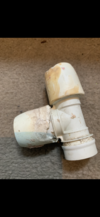You are using an out of date browser. It may not display this or other websites correctly.
You should upgrade or use an alternative browser.
You should upgrade or use an alternative browser.
Expanding foam with plastic pipes & cables
- Thread starter hard-work
- Start date
Sponsored Links
The manufacturers of polyurethane expanding foams appear to say yes. I can't speak for pipes, but I've certainly had PVC cables in contact with such foam for many years without any apparent ill effects.What is on the web appears many years old. Are foams safe with plastic pipes and cables?
Kind Regards, John
It would be interesting to know if there are any adverse affects on barrier pipe, Speedfit, Hep2O, etc. If so, how long would it take for the pipe to deteriorate. The same with cables. It may take many years (10-15?) for the foam to take affect.
If there are affects, I would suspect plastic pipe to be affected more as it expands and contracts more than cable - and leaks.
If there are affects, I would suspect plastic pipe to be affected more as it expands and contracts more than cable - and leaks.
From my (albeit fairly limited) understanding of the chemistry, I don't think there is any real reason to think that there will ever be any harmful effect, since, once the solvents have gone/evaporated (which happens early), I think polyurethane foam is pretty inert - and, being essentially a closed-cell foam, has little ability to absorb anything.It would be interesting to know if there are any adverse affects on barrier pipe, Speedfit, Hep2O, etc. If so, how long would it take for the pipe to deteriorate. The same with cables. It may take many years (10-15?) for the foam to take affect.
It's a different matter with expanded polystyrene foam (sheets of which used to be used as insulation), long-term contact of which with PVC cables can result in leaching out of the plasticisers, leading top the PVC cable sheath potentially becoming brittle. However, I think that even that takes a good few years.
Kind Regards, John
Sponsored Links
- Joined
- 6 Dec 2022
- Messages
- 3
- Reaction score
- 0
- Country

What is on the web appears many years old. Are foams safe with plastic pipes and cables?
Expanding foams are not safe with plastics, see the picture.
The foam makes the plastic brittle on the water fittings causing leaks. Avoid using any foam.
The fitting had to be changed as it was dripping water through into the ceiling.
Even I did not think it was possible for foam to damage a plastic fitting!
Using foams is very messy, if you have gaps that need to be filled just use rock wool.
People like expanding foams as it is easy and enjoy pressing a nozzle giving them a sense of control!
Attachments
- Joined
- 6 Dec 2022
- Messages
- 3
- Reaction score
- 0
- Country

What is on the web appears many years old. Are foams safe with plastic pipes and cables?
- Joined
- 6 Dec 2022
- Messages
- 3
- Reaction score
- 0
- Country

I would avoid any use of expanding foam on any plastic, you can see the foam has eaten away at the Hep2O fitting. The effect to rot this away was over time.
Expanding foam is only useful for masonary gaps and filling in gaps in PIR board insulation.
Hope this helps
Expanding foam is only useful for masonary gaps and filling in gaps in PIR board insulation.
Hope this helps
I would avoid any use of expanding foam on any plastic, you can see the foam has eaten away at the Hep2O fitting. The effect to rot this away was over time.
Expanding foam is only useful for masonary gaps and filling in gaps in PIR board insulation.
Hope this helps
I haven't come across that before.
I know that acetone is a solvent for expanding foam but I would expect that it once the foam has cured, it is stable.
DIYnot Local
Staff member
If you need to find a tradesperson to get your job done, please try our local search below, or if you are doing it yourself you can find suppliers local to you.
Select the supplier or trade you require, enter your location to begin your search.
Please select a service and enter a location to continue...
Are you a trade or supplier? You can create your listing free at DIYnot Local
Sponsored Links
Similar threads
- Replies
- 4
- Views
- 10K

